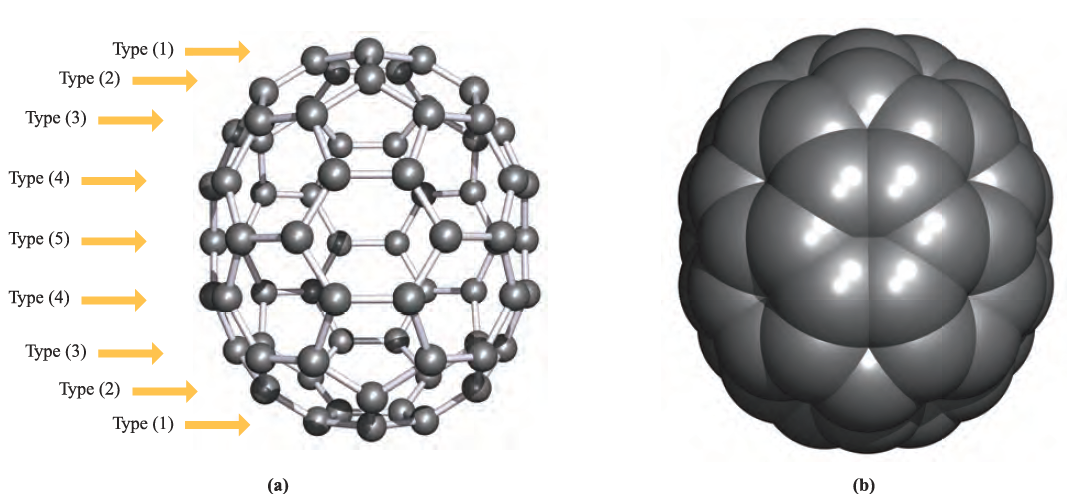


 علم الكيمياء
علم الكيمياء 
 الكيمياء التحليلية
الكيمياء التحليلية 
 الكيمياء الحياتية
الكيمياء الحياتية 
 الكيمياء العضوية
الكيمياء العضوية 
 الكيمياء الفيزيائية
الكيمياء الفيزيائية
 الكيمياء اللاعضوية
الكيمياء اللاعضوية 
 مواضيع اخرى في الكيمياء
مواضيع اخرى في الكيمياء
 الكيمياء الصناعية
الكيمياء الصناعية |
Read More
Date: 14-5-2020
Date: 9-7-2020
Date: 2-2-2018
|
Fullerenes: synthesis and structure
In 1985, Kroto, Smalley and coworkers discovered that, by subjecting graphite to laser radiation at >10 000 K, new allotropes of carbon were formed. The fullerenes are named after architect Buckminster Fuller, known for designing geodesic domes. Each fullerene is molecular and the family includes C60, C70, C76, C78, C80 and C84. Several synthetic routes to fullerenes have been developed; C60 and C70 are the major components of the mixture formed when graphitic soot is produced as graphite rods are evaporated (by applying an electrical arc between them) in a helium atmosphere at ≈130 bar and the vapour condensed. Extraction of the soot into benzene yields a red solution from which C60 and C70 can be separated by chromatography. Hexane or benzene solutions of C60 are magenta, while those of C70 are red. Both C60 and C70 are now available commercially, and this has encouraged rapid exploration of their chemical properties. Figure a shows the structure of C60. Although a number of X-ray diffraction studies of C60 have been carried out, the near-spherical shape of the molecule has led to frustrating orientational disorder (see Section 18.3) problems. The C60 molecule belongs to the Ih point group and consists of an approximately spherical network of atoms which are connected in 5- and 6-membered rings; all the C atoms are equivalent, as indicated by the fact that the 13C NMR spectrum of C60 exhibits one signal (δ + 143). The rings are arranged such that no 5-membered rings are adjacent to each other. Thus, C60 (the smallest fullerene that can be isolated as a stable species) satisfies the Isolated Pentagon Rule (IPR).† The separation of the 5-membered rings by 6-membered rings is easily seen in the schematic representation of C60 shown in Figure1.1b which also gives a bonding scheme.

Fig.1.1 (a) The structure of the fullerene C60; the approximately spherical molecule is composed of fused 5- and 6-membered rings of carbon atoms. [X-ray diffraction at 173K of the benzene solvate C60 4C6H6, M.F. Meidine et al. (1992) J. Chem. Soc., Chem. Commun., p. 1534.] (b) A representation of C60, in the same orientation as is shown in (a), but showing only the upper surface and illustrating the localized single and double carbon–carbon bonds.
Each C atom is covalently bonded to three others in an approximately trigonal planar arrangement; the relatively large surface of the ‘sphere’ means that there is only slight deviation from planarity at each C centre. There are two types of C_C bond: those at the junctions of two hexagonal rings (6,6- edges) are of length 139 pm, while those between a hexagonal and a pentagonal ring (5,6-edges) are longer, 145.5 pm. These differences indicate the presence of localized double and single bonds, and similar bonding descriptions are appropriate for other fullerene cages. We consider chemical evidence for the presence of C=C double bonds below. After C60, the next smallest fullerene to satisfy the IPR is C70. The C70 molecule has D5h symmetry and is approximately ellipsoidal (Figure1.2); it comprises 6- and 5-membered rings organized so that, as in C60, 5-membered rings are never adjacent. The 13C NMR spectrum of C70 confirms that there are five C environments in solution, consistent with the solid state structure (Figure1.2a).

Fig.1.2 The structure of C70 determined from an X-ray diffraction study of C70 6S8 [H.B. Burgi et al. (1993) Helv. Chim. Acta, vol. 76, p. 2155]: (a) a ball-and-stick representation showing the five carbon atom types, and (b) a space-filling diagram illustrating the ellipsoidal shape of the molecule.



|
|
|
|
تفوقت في الاختبار على الجميع.. فاكهة "خارقة" في عالم التغذية
|
|
|
|
|
|
|
أمين عام أوبك: النفط الخام والغاز الطبيعي "هبة من الله"
|
|
|
|
|
|
|
مكتب المرجع الديني الأعلى يعزّي باستشهاد عددٍ من المؤمنين في باكستان
|
|
|